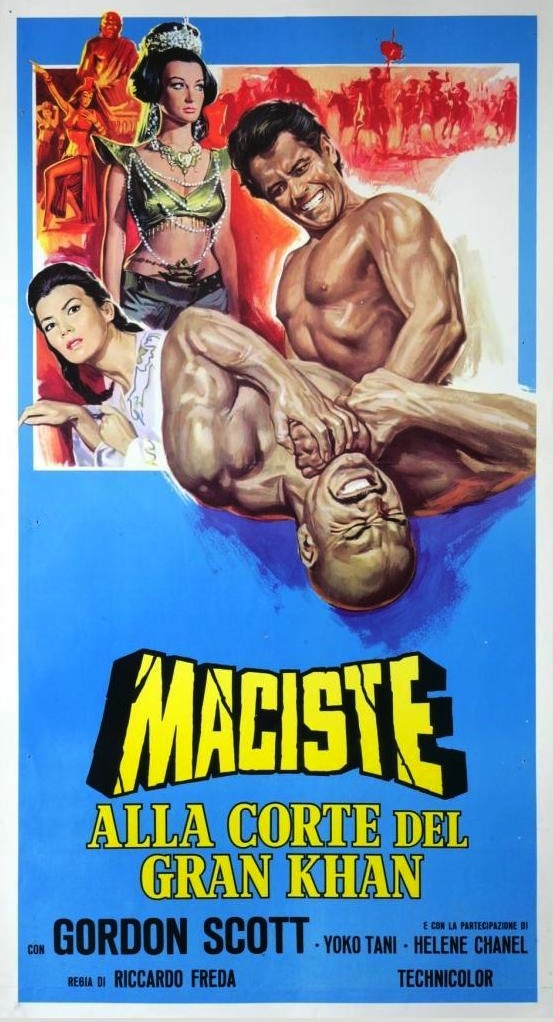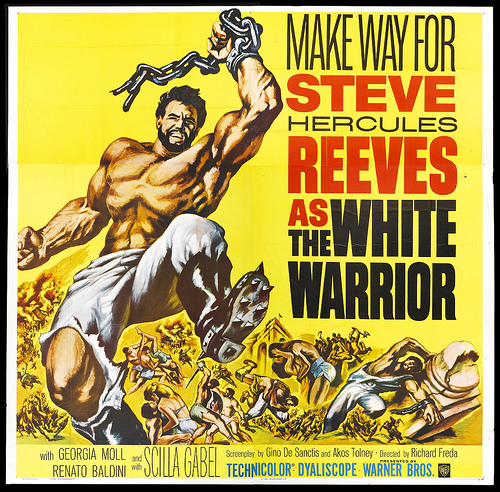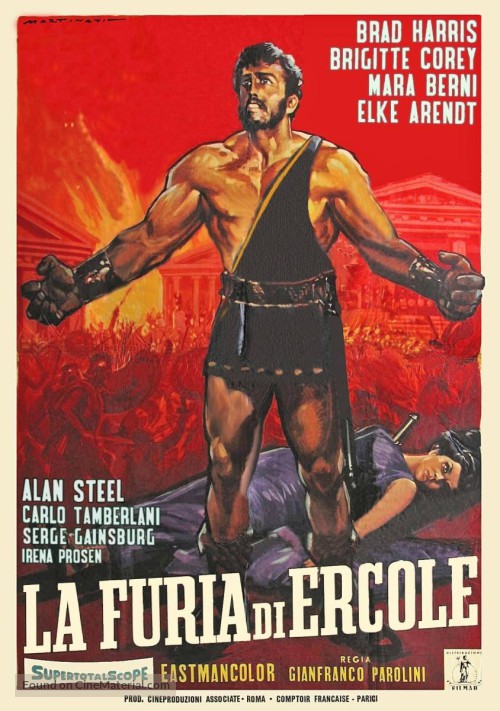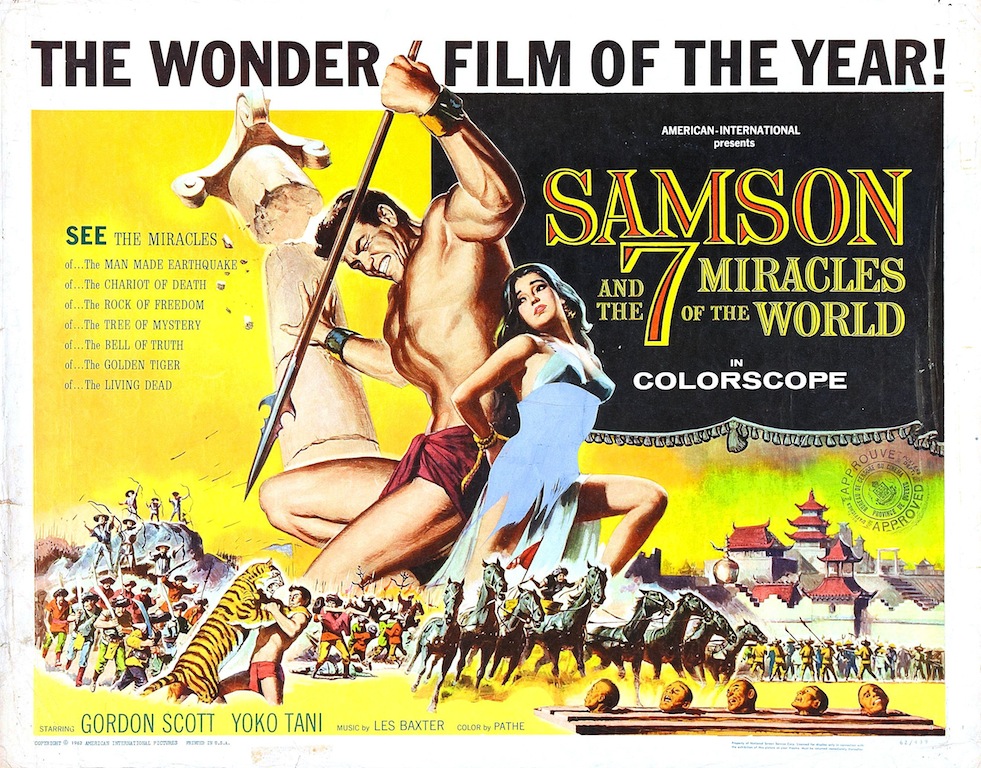Peplum Populist: Short Takes on Three Streaming Titles
When I first set out to write articles about Italian peplum (sword-and-sandal) films, my intention was to excavate for worthwhile titles available from the quarry of low-quality streaming options. But my intention started to skid, and now I’m turning into the skid. I’ve already dealt with a quality film you can only get on DVD (Hercules, Samson & Ulysses) and a high-quality streaming film you shouldn’t watch (Colossus of the Stone Age). The more I sort through the archives of sword-and-sandal flicks on Amazon Video, the more limited I find the options for movies in even the most modestly acceptable presentation.
So while I continue to sift through streaming choices and look into DVDs from boutique labels, here are three short takes on films in the Amazon Video library (all free for Prime members) that don’t pass my normal picture quality threshold, but may be interesting to the Black Gate readers who can grit their teeth and struggle through blurred, pan-and-scan transfers.
 Samson and the 7 Miracles of the World (1961)
Samson and the 7 Miracles of the World (1961)
I’m unsure what the “seven miracles” of the English title of this Maciste film are (i.e. Maciste at the Court of the Great Khan). It’s probably yet another way for a company like U.S. distributor American International to grab at the fantasy popularity of The 7th Voyage of Sinbad. There’s an enormous bell and also a chariot with a head-cutting razor blade on it, which seems miraculous to me. The finale has Maciste create an earthquake from beneath the Mongol’s city where they’ve entombed him and this may count as the only actual miracle — but, yes, it’s impressive.
I think this is a high-quality piece of peplum pop cinema. But I can’t be certain because it has one of the most craptastic transfers I’ve found in Amazon’s peplum library. Even among already rock-bottom standards, this looks dreadful. I suspect it was transferred from VHS; it’s that blurry. It amazes me I was even able to get accustomed enough to it to watch the entire film, although I spread it out over three days and watched from a laptop screen rather than permit a large Ultra HD monitor to make the low-resolution look substantially worse.
Gordon Scott plays Maciste/Samson, who has found his way to China under the rule of Garak, the Great Khan of the Mongols. He also finds existing Chinese sets from another film made by the production company, which shot three Maciste movies with different actors. The far eastern setting may be different for a sword-and-sandal story, but Maciste is up to his regular routine of helping rebels against an oppressive tyrant and bringing together a pair of young lovers. He also busts up a bar in spectacular fashion and battles a tiger, two genre standards I never grow tired of watching.
Any quality peplum needs at least one lunatic set-piece to make it memorable despite the ritualized elements. Samson and the 7 Miracles has a doozy in its chariot sequence. Maciste executes the same stunt Raiders of the Lost Ark would make famous of the hero going under a speeding vehicle, but this was already an established stunt from Yakima Canutt in Westerns of the ‘30s and ‘40, such as When the Daltons Rode (1940). The major appeal of the sequence is that the chariot is outfitted for an absurdly over-the-top execution method, where a blade on the underside of the carriage rides over men buried in the ground with their heads exposed and neatly lops off their noggins. We don’t see this happen to actual people, only wooden test dummies, because Maciste leaps in to stop it. Wickedly fun idea, however.
There are a few genuine Asian actors in the cast, which is a legitimate shock since even U.S. movies of the early 1960s liked to go with yellowface performers for these parts. Leading lady Yoko Tani was a Japanese actress who showed up in a number of European films during the decade, such as MST3k subject First Spaceship on Venus. But there are still too many Italian actors passed off as Chinese or Mongolian with the barest attempt to disguise their ethnicity. Leonardo Severini as the Great Khan doesn’t even have what might pass for Mongolian clothing, sporting instead what looks like a Flemish merchant cap.
Gordon Scott is my second favorite peplum strongman actor after Steve Reeves, although that’s probably because of his starring role in two of the best Tarzan films. The same voice actor who dubbed Reeves in the U.S. release of Hercules, Norman Rose, also dubs Scott here. I’m fine with Gordon Scott’s actual voice, but the deep, smooth timbre of Norman Rose resonates in a special way with this genre.
As mentioned before, I think this is all fantastic sword-and-sandal fun — if only I could get through the visual sludge of the public domain print. Some moments shine through the grating presentation, such as the sets for the Great Khan’s palace and a few large-scale bow-and-arrow action scenes. How much better they would be in the proper aspect ratio and even a minor improvement in print quality!
 The White Warrior (1959)
The White Warrior (1959)
A setting of mid-nineteenth-century Russia sounds like it falls outside of the purview of pepla, but Russia featured in a few genre entries, such as two 1964 Kirk Morris films, Atlas against the Czar (actually a Maciste film, big surprise) and Terror of the Steppes. The White Warrior is the most famous of these “sword-and-Tsar” films, and in story and execution it’s almost pure peplum filmmaking. The presence of Steve Reeves at the height of his fame playing a muscular warrior leading scrappy rebels against a cruel oppressor is as standard a set-up as you can have for the genre. Plus: a ceremonial dance number, an opening with a raid on a helpless village, Reeves flexing his thews in a shirtless wrestling contest, and a sword-swinging and fist-pummeling closer. Consider this the peplum version of War and Peace. Especially since it’s based loosely on Leo Tolstoy’s final novel, Hadji Murat. You don’t often have Steve Reeves and Leo Tolstoy sharing credit on a film.
Tolstoy’s short novel about the Caucasus Mountains freedom fighter Hadji Murat is only a framework for a conventional Rebels vs. Tyrant adventure yarn. Tolstoy’s moral complexity and spiritual themes are gone in favor of a straightforward battle between Murat’s Caucasian tribes and the forces of Czar Nicholas I and his general, Prince Sergei (Gérard Herter). Murat has a rival among the tribes, Ahmed Khan (Renato Baldini), who’s jealous of Murat’s popularity and wants the hero’s true love, Sultanate (Giorgia Moll), for himself. When Murat ends up a captive of Prince Sergei, he’s under pressure to sign a treaty to betray his people. Of course Murat won’t do it, and when he breaks free he’s going to want vengeance on Ahmed, who schemed to push Murat from the favor of the rebel king.
The White Warrior could use more peplum pulse. For all the gorgeous sets and costumes — typical of the bigger movies Steve Reeves headlined — the film starts to drag after the Russians capture Hadji Murat. Instead of focusing on the capture of a key Russian-held fortress, as the early sequences promise will be the center of the action, the movie switches to a tedious rotation of scenes with Prince Sergei lecturing Murat to sign a peace treaty and Sergei’s wife Maria (Scialla Gabel from Tarzan’s Greatest Adventure) begging for him to show mercy to Murat. In the last five minutes, events rush to a conclusion and feature horse stunts, violent dueling, and fisticuffs. But too much air has already been let out of the film. It feels as if “prestige picture” illness struck — a yearning to look more like a Hollywood historical drama — and the boisterous action scenes that more suit a Steve Reeves vehicle were shunted aside.
As far the the prestige picture part goes, The White Warrior nails the look, with sumptuous costumes and extravagant sets. Reeves struts around in a striking all-white uniform with matching cape and fur hat, and leading ladies Scialla Gabel and Giorgia Moll are lavished with visual glamour akin to MGM in the 1940s. It’s unfortunate the pan-and-scan presentation of Amazon’s transfer dulls this visual magnificence, particularly the photography from future horror legend Mario Bava. Bava was already starting his own directing career at the time and would soon head up one of the greatest sword-and-sandal films, Hercules in the Haunted World. Even in the cropped and blurry transfer on Amazon, Bava’s color sense bursts through. The transfer at least isn’t faded, so this much of Bava’s achievement survives. Bava also makes powerful use of darkness, letting characters emerge from shadows across their faces during dialogue scenes.
Another point in The White Warrior ’s favor is that it’s always pleasant having Steve Reeves on screen, especially when Norman Rose is supplying the mythic vocal tones. I’ve come to accept Norman Rose as the voice of Steve Reeves, even though I know what Reeve’s actual speaking voice sounds like. Reeves became a Eurostar for good reasons: he wasn’t a heavyweight as a performer, but he commands the screen, looks great bashing people in the face with guns (he rarely actually fires guns), and never feels less than 100% committed to being the early 1960s equivalent of a granite-jawed superhero.
 The Fury of Hercules (1962)
The Fury of Hercules (1962)
It wouldn’t be right to leave out a Hercules film from my viewing, and this is an actual Herc starring vehicle, not a retitled Maciste joint. The same cast and crew responsible for Samson (1961) reassembled to do essentially the same story. But since it’s the story of 75% of all sword-and-sandal films — including the two I just wrote about — does it make that much of a difference? No, not really. Unfortunately, this is one of the more generic examples of the peplum plot I’ve seen, hitting the expected notes while offering up few of the thrills.
Once more, a Greek city suffers under an evil ruler, and Hercules joins the rebels after he discovers the tyranny. The city of Arpad (if I’m hearing the name on the garbled soundtrack right) is ruled by Queen Cnidia (Mara Berni), who’s obsessed with securing the city with the construction of gigantic walls. Her single-mindedness has allowed the actual management of Arpad (am I hearing this name correctly?) to fall to the scheming of her villainous advisor, Menistus (Serge Gainsbourg, a famous French pop musician and songwriter). Hercules falls in with Daria (Luisella Boni), a spy for the rebel leader, while Cnidia falls hard for Hercules and only at the last minute wakes up to Menistus’s plans to … uhm, I’m not sure, but I guess they’re wicked because Serge Gainsbourg looks untrustworthy at all times.
None of this business-as-usual needs to add up to a poor film, but The Fury of Hercules contains extraneous details that don’t affect the story except to create clutter. There’s too many subplots running through the various rebel characters, none of which have time to blossom into anything interesting and end up taking away the Hercules action the movie needs more of. Until the finale Herc doesn’t take initiative or have much to do. Only after Cnidia rescues him from a pit of poison gas — the sort of trap Hercules is supposed to escape from on his own — does he fly into into battle mode for the final fifteen minutes. The last tussle with Alan Steel as Menistus’s mute henchman Kaldos is a highlight, but it needed to go on for even longer. It’s easy to see from this scene why Steel (screen name of Sergio Ciani) went on to headline his own sword-and-sandal films. Kaldos is a character who deserved more time, rather than having it wasted it on the bland rebels and their domestic plans.
The central set piece isn’t as good as the decapitating chariot in Samson and the 7 Miracles, but it does have variety in its favor. Hercules must overcome three trials on a time-limit to win the freedom of rebel woman about to be executed. The trials are 1) fight a lion, 2) fight an ape-man in a chamber with crushing walls, and 3) defeat Kaldos in a duel over a bed of spikes. The first two challenges come straight from the peplum manual, and the ape costume may even be re-used. The gimmick fight with Kaldos adds something new, but the combatants quickly break free from the restraints keeping them over the spikes and have it out in a more routine fashion.
The transfer quality is a bit above Samson and the 7 Miracles of the World but is still wretched. The print is faded brown so it looks like Mythic Greece is suffering from a constant smog alert. The muffled sound makes most of the names hard to discern. I’m still unsure if the city is called “Arpad” or not, and I could never make a decent guess as to the name of the woman Herc rescues in the challenges, only that it starts with an “L.” The subtitles are no help: they think her name is [INAUDIBLE].
Director Gianfranco Parolini would go on to better films in the Western genre. He helmed two minor classics, If You Meet Sartana Pray for Your Death (1968) and Sabata (1969), the latter of which starred Lee Van Cleef. Parolini directed two more Sabata films, Adiós, Sabata (1970) with Yul Brynner in the lead — originally a different character named Indio Black — and The Return of Sabata (1971) again with Van Cleef. These films have a comic playfulness and love of gadgetry that would have spiced up The Fury of Hercules.
By the way, the Italian title of Adiós, Sabata translates as “Indio Black, You Know What I’m Going to Tell You: You’re a Big Son of a …” I wish sword-and-sandal films had titles like this: Hercules Is Here — Sacrifice an Extra Goat to Artemis, You Impious Bastard.
Ryan Harvey is one of the original bloggers for Black Gate, starting in 2008. He received the Writers of the Future Award for his short story “An Acolyte of Black Spires,” and his stories “The Sorrowless Thief” and “Stand at Dubun-Geb” are available in Black Gate online fiction. A further Ahn-Tarqa adventure, “Farewell to Tyrn”, is currently available as an e-book. Ryan lives in Costa Mesa, California where he works as a professional writer for a marketing company. Occasionally, people ask him to talk about Edgar Rice Burroughs or Godzilla in interviews.

I love sword and sandal films. Lots of other “B” movies, considering them an art in itself. Have to check YouTube, might have these on there.
Nowadays, Sword and Sandals remind me of my hate then love relationship with “Mystery Science Theater 3000”. For a while a few movies I was wanting to find couldn’t be found without paying $100 and hoping some obscure catalog was still active and had an 8mm reel, which I didn’t have a projector for. So, some films I could only practically watch on MST3K. And I hated the heckling robots…
Years later, most of these movies were dumped to dirt cheap VHS, then Dirt cheap DVDs – finally mostly being shown for free on YouTube.
And I missed the Heckling Robots… Glad that show is back on Netflix.
On Sword and Sandal- has anyone seen the 80s Lou Ferrignio Hercules? I mean, he’s done a lot, but there were some especially “Bad” (Doublespeak bad=good) ones with cheezy 80s Xanadu hair, mechanical stop motion monsters and cheap 80s FX of painted neon glows and expensive but cheap looking computer effects (modifying 2D graphics)
Loved that film. And the sequel.
Had Lou on a horse riding. He was so muscular he put his horse to shame! I wanted to grab some coconuts and go “Ca-plop! Ca-Plop!” Worth it too for Sybil Danning wearing revealing outfits and trying to imitate Boris covers.
Sometime in the fall of 1962, I discovered that Channel 10 in Columbus, OH, ran a Friday night program called “Chiller Theater” (don’t know if this is the same program non-Ohioans fondly recall). I saved up paper route money and bought myself a portable B&W TV, complete with earphone jack (so I didn’t wake up my brother) and watched from the safety and comfort of my bedroom (I got scared easy in those days. Hey — I was 12). One summer, I was babysitting brother & two sisters on a Saturday night, and the same channel aired movies after the news, usually grainy reel-to-reel oldies, and all too often badly dubbed foreign films. But what would ordinarily have been something I kept on in the background, while I played card games until mom and dad got home, got my undivided attention when I saw the first of I-didn’t-know how many Italian flicks that I now can only remember the theme music to: “Mighty Sons of Hercules.” To a junior high/high school kid in 1964/5, these were about as much fun as you could have in a big house all by yourself at midnight. My oldest sister stayed up with me one night, and she got caught up in them, too. What she remembered best was the music Channel 10 used as their intro to all their Saturday night movies for a while, something I couldn’t identify until I was much older: The overture to Mozart’s “Die Fledermaus.” I guess it’s not common to connect late-18th century opera with 20th century sword-and-sandal silliness, but those remain some of my fondest memories of growing up in Cold War America.
For anyone interested, Wikipedia says there were 14 movies under the “Sons of Hercules” label, and you can hear that theme on YouTube, also.